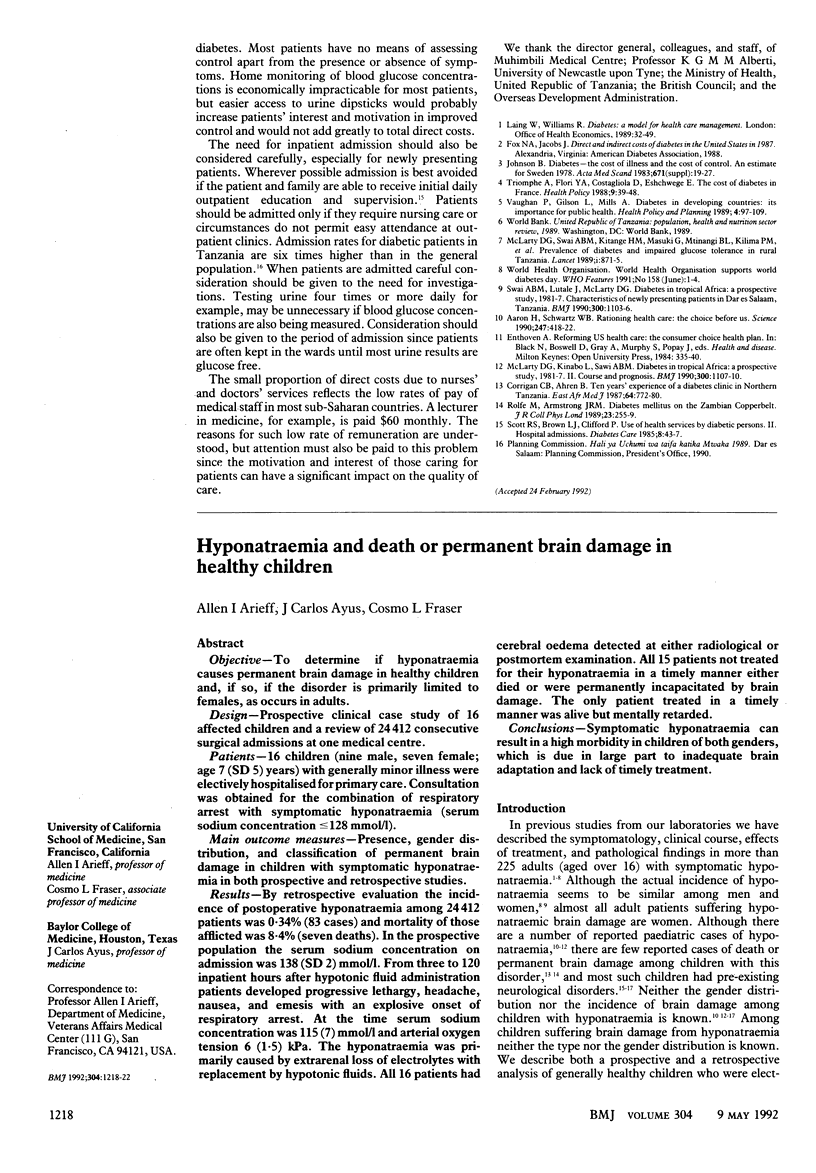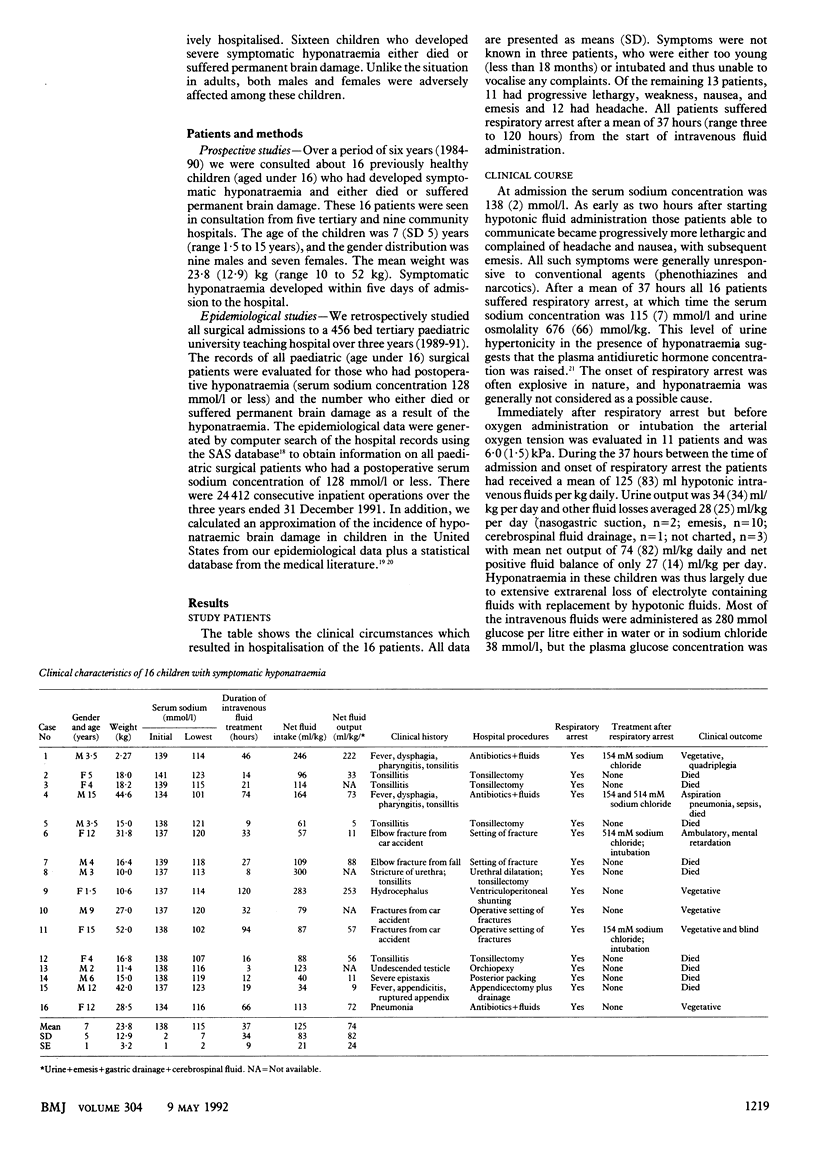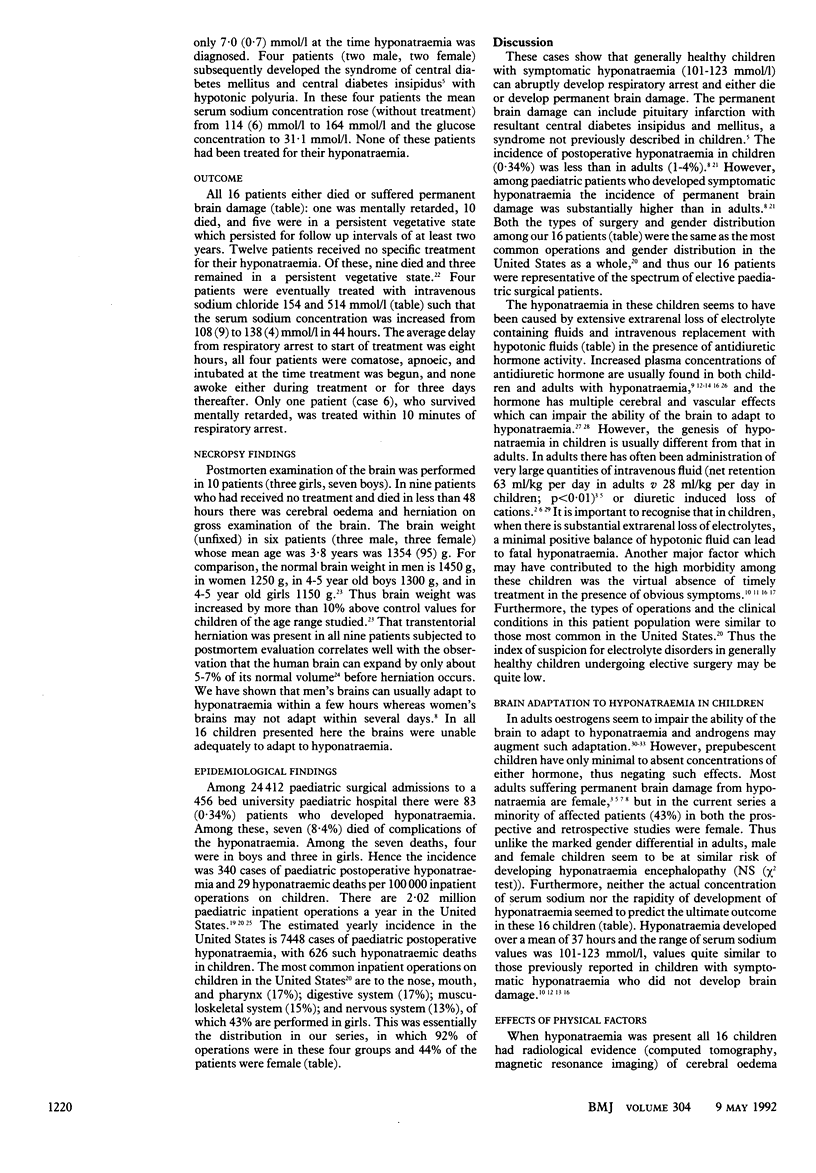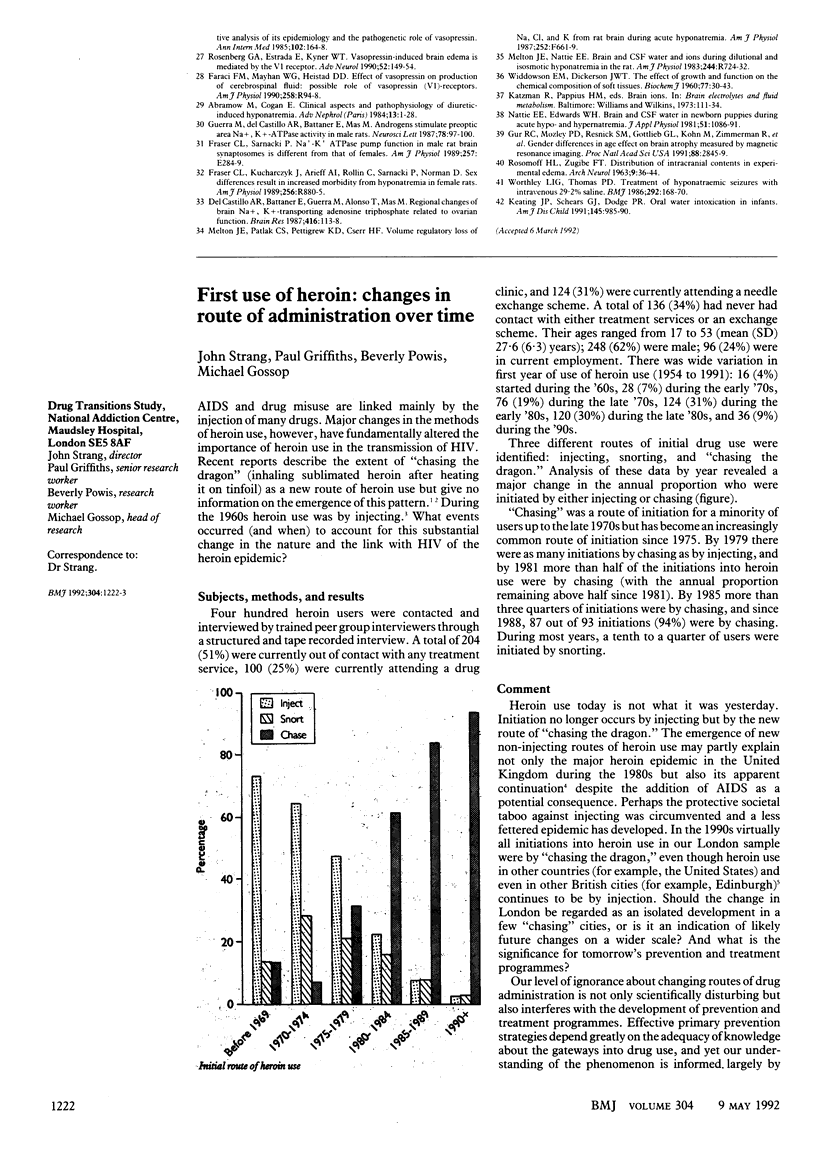Abstract
OBJECTIVE--To determine if hyponatraemia causes permanent brain damage in healthy children and, if so, if the disorder is primarily limited to females, as occurs in adults. DESIGN--Prospective clinical case study of 16 affected children and a review of 24,412 consecutive surgical admissions at one medical centre. PATIENTS--16 children (nine male, seven female; age 7 (SD 5) years) with generally minor illness were electively hospitalised for primary care. Consultation was obtained for the combination of respiratory arrest with symptomatic hyponatraemia (serum sodium concentration less than or equal to 128 mmol/l). MAIN OUTCOME MEASURES--Presence, gender distribution, and classification of permanent brain damage in children with symptomatic hyponatraemia in both prospective and retrospective studies. RESULTS--By retrospective evaluation the incidence of postoperative hyponatraemia among 24,412 patients was 0.34% (83 cases) and mortality of those afflicted was 8.4% (seven deaths). In the prospective population the serum sodium concentration on admission was 138 (SD 2) mmol/l. From three to 120 inpatient hours after hypotonic fluid administration patients developed progressive lethargy, headache, nausea, and emesis with an explosive onset of respiratory arrest. At the time serum sodium concentration was 115 (7) mmol/l and arterial oxygen tension 6 (1.5) kPa. The hyponatraemia was primarily caused by extrarenal loss of electrolytes with replacement by hypotonic fluids. All 16 patients had cerebral oedema detected at either radiological or postmortem examination. All 15 patients not treated for their hyponatraemia in a timely manner either died or were permanently incapacitated by brain damage. The only patient treated in a timely manner was alive but mentally retarded. CONCLUSIONS--Symptomatic hyponatraemia can result in high morbidity in children of both genders, which is due in large part to inadequate brain adaptation and lack of timely treatment.
Full text
PDF




Selected References
These references are in PubMed. This may not be the complete list of references from this article.
- Abramow M., Cogan E. Clinical aspects and pathophysiology of diuretic-induced hyponatremia. Adv Nephrol Necker Hosp. 1984;13:1–28. [PubMed] [Google Scholar]
- Anderson R. J., Chung H. M., Kluge R., Schrier R. W. Hyponatremia: a prospective analysis of its epidemiology and the pathogenetic role of vasopressin. Ann Intern Med. 1985 Feb;102(2):164–168. doi: 10.7326/0003-4819-102-2-164. [DOI] [PubMed] [Google Scholar]
- Arieff A. I. Hyponatremia, convulsions, respiratory arrest, and permanent brain damage after elective surgery in healthy women. N Engl J Med. 1986 Jun 12;314(24):1529–1535. doi: 10.1056/NEJM198606123142401. [DOI] [PubMed] [Google Scholar]
- Arieff A. I., Llach F., Massry S. G. Neurological manifestations and morbidity of hyponatremia: correlation with brain water and electrolytes. Medicine (Baltimore) 1976 Mar;55(2):121–129. doi: 10.1097/00005792-197603000-00002. [DOI] [PubMed] [Google Scholar]
- Ashraf N., Locksley R., Arieff A. I. Thiazide-induced hyponatremia associated with death or neurologic damage in outpatients. Am J Med. 1981 Jun;70(6):1163–1168. doi: 10.1016/0002-9343(81)90822-6. [DOI] [PubMed] [Google Scholar]
- Ayus J. C., Krothapalli R. K., Arieff A. I. Treatment of symptomatic hyponatremia and its relation to brain damage. A prospective study. N Engl J Med. 1987 Nov 5;317(19):1190–1195. doi: 10.1056/NEJM198711053171905. [DOI] [PubMed] [Google Scholar]
- Burrows F. A., Shutack J. G., Crone R. K. Inappropriate secretion of antidiuretic hormone in a postsurgical pediatric population. Crit Care Med. 1983 Jul;11(7):527–531. doi: 10.1097/00003246-198307000-00009. [DOI] [PubMed] [Google Scholar]
- Chung H. M., Kluge R., Schrier R. W., Anderson R. J. Postoperative hyponatremia. A prospective study. Arch Intern Med. 1986 Feb;146(2):333–336. [PubMed] [Google Scholar]
- Cowley D. M., Pabari M., Sinton T. J., Johnson S., Carroll G., Ryan W. E. Pathogenesis of postoperative hyponatraemia following correction of scoliosis in children. Aust N Z J Surg. 1988 Jun;58(6):485–489. doi: 10.1111/j.1445-2197.1988.tb06240.x. [DOI] [PubMed] [Google Scholar]
- Crumpacker R. W., Kriel R. L. Voluntary water intoxication in normal infants. Neurology. 1973 Nov;23(11):1251–1255. doi: 10.1212/wnl.23.11.1251. [DOI] [PubMed] [Google Scholar]
- David R., Ellis D., Gartner J. C. Water intoxication in normal infants: role of antidiuretic hormone in pathogenesis. Pediatrics. 1981 Sep;68(3):349–353. [PubMed] [Google Scholar]
- Dekaban A. S. Changes in brain weights during the span of human life: relation of brain weights to body heights and body weights. Ann Neurol. 1978 Oct;4(4):345–356. doi: 10.1002/ana.410040410. [DOI] [PubMed] [Google Scholar]
- Fraser C. L., Arieff A. I. Fatal central diabetes mellitus and insipidus resulting from untreated hyponatremia: a new syndrome. Ann Intern Med. 1990 Jan 15;112(2):113–119. doi: 10.7326/0003-4819-112-2-113. [DOI] [PubMed] [Google Scholar]
- Fraser C. L., Kucharczyk J., Arieff A. I., Rollin C., Sarnacki P., Norman D. Sex differences result in increased morbidity from hyponatremia in female rats. Am J Physiol. 1989 Apr;256(4 Pt 2):R880–R885. doi: 10.1152/ajpregu.1989.256.4.R880. [DOI] [PubMed] [Google Scholar]
- Fraser C. L., Sarnacki P. Na+-K+-ATPase pump function in rat brain synaptosomes is different in males and females. Am J Physiol. 1989 Aug;257(2 Pt 1):E284–E289. doi: 10.1152/ajpendo.1989.257.2.E284. [DOI] [PubMed] [Google Scholar]
- Garcia J. H., Conger K. A., Morawetz R., Halsey J. H., Jr Postischemic brain edema: quantitation and evolution. Adv Neurol. 1980;28:147–169. [PubMed] [Google Scholar]
- Gross P. A., Pehrisch H., Rascher W., Schömig A., Hackenthal E., Ritz E. Pathogenesis of clinical hyponatremia: observations of vasopressin and fluid intake in 100 hyponatremic medical patients. Eur J Clin Invest. 1987 Apr;17(2):123–129. doi: 10.1111/j.1365-2362.1987.tb02391.x. [DOI] [PubMed] [Google Scholar]
- Guerra M., Rodriguez del Castillo A., Battaner E., Mas M. Androgens stimulate preoptic area Na+,K+-ATPase activity in male rats. Neurosci Lett. 1987 Jul 9;78(1):97–100. doi: 10.1016/0304-3940(87)90568-4. [DOI] [PubMed] [Google Scholar]
- Gur R. C., Mozley P. D., Resnick S. M., Gottlieb G. L., Kohn M., Zimmerman R., Herman G., Atlas S., Grossman R., Berretta D. Gender differences in age effect on brain atrophy measured by magnetic resonance imaging. Proc Natl Acad Sci U S A. 1991 Apr 1;88(7):2845–2849. doi: 10.1073/pnas.88.7.2845. [DOI] [PMC free article] [PubMed] [Google Scholar]
- Jennett B., Plum F. Persistent vegetative state after brain damage. A syndrome in search of a name. Lancet. 1972 Apr 1;1(7753):734–737. doi: 10.1016/s0140-6736(72)90242-5. [DOI] [PubMed] [Google Scholar]
- Judd B. A., Haycock G. B., Dalton N., Chantler C. Hyponatraemia in premature babies and following surgery in older children. Acta Paediatr Scand. 1987 May;76(3):385–393. doi: 10.1111/j.1651-2227.1987.tb10487.x. [DOI] [PubMed] [Google Scholar]
- Keating J. P., Schears G. J., Dodge P. R. Oral water intoxication in infants. An American epidemic. Am J Dis Child. 1991 Sep;145(9):985–990. doi: 10.1001/archpedi.1991.02160090037018. [DOI] [PubMed] [Google Scholar]
- Melton J. E., Nattie E. E. Brain and CSF water and ions during dilutional and isosmotic hyponatremia in the rat. Am J Physiol. 1983 May;244(5):R724–R732. doi: 10.1152/ajpregu.1983.244.5.R724. [DOI] [PubMed] [Google Scholar]
- Melton J. E., Patlak C. S., Pettigrew K. D., Cserr H. F. Volume regulatory loss of Na, Cl, and K from rat brain during acute hyponatremia. Am J Physiol. 1987 Apr;252(4 Pt 2):F661–F669. doi: 10.1152/ajprenal.1987.252.4.F661. [DOI] [PubMed] [Google Scholar]
- Nattie E. E., Edwards W. H. Brain and CSF water and ions in newborn puppies during acute hypo- and hypernatremia. J Appl Physiol Respir Environ Exerc Physiol. 1981 Nov;51(5):1086–1091. doi: 10.1152/jappl.1981.51.5.1086. [DOI] [PubMed] [Google Scholar]
- Rodriguez del Castillo A., Battaner E., Guerra M., Alonso T., Mas M. Regional changes of brain Na+,K+-transporting adenosine triphosphatase related to ovarian function. Brain Res. 1987 Jul 21;416(1):113–118. doi: 10.1016/0006-8993(87)91502-2. [DOI] [PubMed] [Google Scholar]
- Rosenberg G. A., Estrada E., Kyner W. T. Vasopressin-induced brain edema is mediated by the V1 receptor. Adv Neurol. 1990;52:149–154. [PubMed] [Google Scholar]
- Sarnaik A. P., Meert K., Hackbarth R., Fleischmann L. Management of hyponatremic seizures in children with hypertonic saline: a safe and effective strategy. Crit Care Med. 1991 Jun;19(6):758–762. doi: 10.1097/00003246-199106000-00005. [DOI] [PubMed] [Google Scholar]
- Varavithya W., Hellerstein S. Acute symptomatic hyponatremia. J Pediatr. 1967 Aug;71(2):269–283. doi: 10.1016/s0022-3476(67)80087-8. [DOI] [PubMed] [Google Scholar]
- WIDDOWSON E. M., DICKERSON J. W. The effect of growth and function on the chemical composition of soft tissues. Biochem J. 1960 Oct;77:30–43. doi: 10.1042/bj0770030. [DOI] [PMC free article] [PubMed] [Google Scholar]
- Worthley L. I., Thomas P. D. Treatment of hyponatraemic seizures with intravenous 29.2% saline. Br Med J (Clin Res Ed) 1986 Jan 18;292(6514):168–170. doi: 10.1136/bmj.292.6514.168. [DOI] [PMC free article] [PubMed] [Google Scholar]


